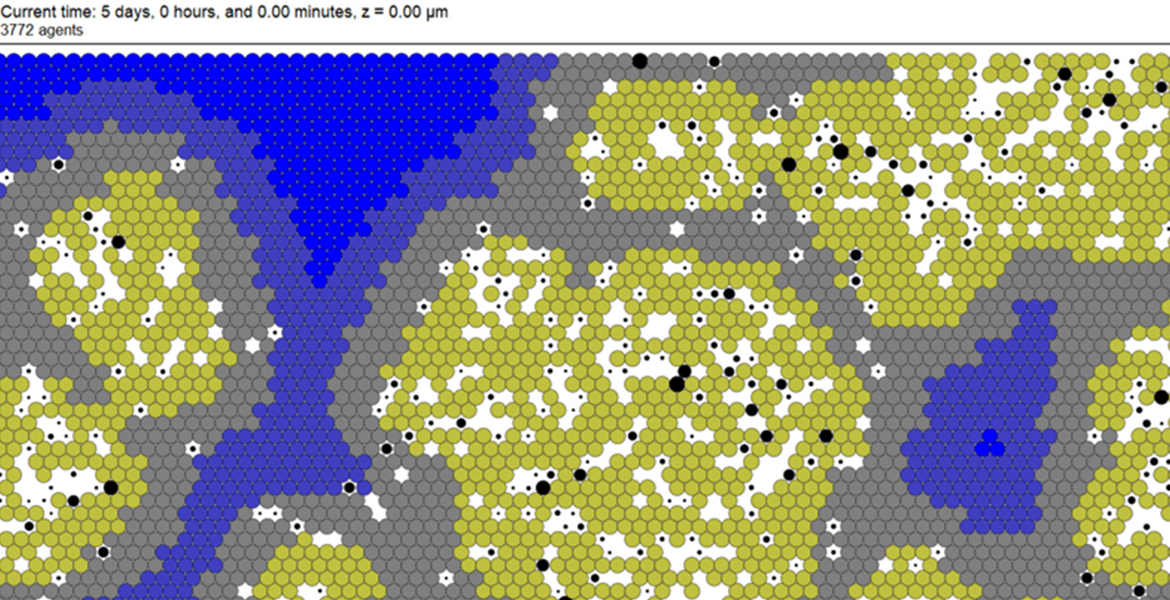
Dr. Ford Versypt's lab works with international coalition to understand the novel coronavirus
Wednesday, May 13, 2020
Dr. Ashlee Ford Versypt, assistant professor in the College of Engineering, Architecture and Technology’s School of Chemical Engineering, and her team are working as part of a coalition to better understand how the novel coronavirus impacts the body.
Ford Versypt and her team are on the tissue damage subteam of the SARS-CoV-2 Tissue Simulation Coalition. The coalition includes a variety of theoretical and experimental collaborators from different universities and industry professionals, led by Dr. Paul Macklin, an associate professor at Indiana University.

Macklin developed a 3D computer modeling system called PhysiCell that has been used to study cancer. The PhysiCell platform allows the user to simulate how cells move, grow, interact, divide and die when exposed to different conditions.
“One Sunday I got a Twitter message from Paul saying that he created a prototype SARS-CoV-2 computer model using the PhysiCell platform, and he wanted to put together a framework to connect individuals with expertise in certain areas to review and enhance the prototype,” Ford Versypt said. “Within that first weekend, people started to coalesce and provide feedback. These were people who had understandings of the first human coronavirus (SARS), influenza and other types of respiratory diseases, so he started to form a team.”
Ford Versypt’s lab studies a receptor called angiotensin converting enzyme 2 (ACE2) which is involved in a biochemical process used to control a person’s blood pressure. An individual’s lungs and airways are rich in ACE2 receptors. Studies have shown that when someone inhales the novel coronavirus, the virus enters into a body’s cells through ACE2 receptors. If the immune system isn’t able to beat the novel coronavirus in the initial stages, then the virus begins moving into other parts of the body.
“One thing my lab studies is ACE2 biochemical processes related to complications in individuals who have diabetes or high blood pressure that can lead to damage in the kidneys,” Ford Versypt explained.
Since patients with diabetes seem to be at a higher risk for developing severe symptoms and dying from the novel coronavirus, Ford Versypt’s team is now working to build computational models to bring clarity about how to maintain a healthy balance of ACE2.
“A healthy balance of ACE2 is needed to control blood pressure, but you also must consider a diabetic’s chronic conditions, their required medications and minimizing the extent of the viral infection in the body,” Ford Versypt said.
Another area that Ford Versypt’s lab is studying is the lung and kidney damage that novel coronavirus patients are experiencing.
“There is mounting evidence that suggests the immune systems in patients may respond too aggressively to the virus, creating a condition called cytokine storm,” Ford Versypt said.
Cytokine storm can lead to inflammation throughout the body and can reduce blood flow to the kidneys, potentially causing fatal damage.
“Cytokine storm effectively kills off the virus,” Ford Versypt continued. “But, at the expense of significant collateral damage to the healthy cells and tissues throughout the body.”
The work her lab is doing with the coalition allows her to test a variety of explanations for the timing and intensity of the infection on a diabetic patient or a patient with high blood pressure, as well as various proposed treatment options to explore the cascade of consequences that may result. Her team does this using mathematical models in the SARS-CoV-2 tissue simulator while getting feedback from other coalition team members.
The SARS-CoV-2 tissue simulator allows the subteams that are working on multiple aspects of viral biology and how the virus effects different parts of the body to each test simulations of what a cell would do under different circumstances in a virtual environment. Ford Versypt said that by doing these virtual simulations each researcher can see what consequences their suggested treatment might have on a patient which would help eliminate treatments that aren’t helpful and cut down on the amount of experiments needed if the findings of the coalition move from the theoretical, prototyping stage, to the experimental stage.
"I really enjoy collaborative science, where it is not just my interpretation of what’s happening, but other people’s interpretations from different backgrounds,” Ford Versypt said. “The results of the research are much more comprehensive.
“The coalition is doing all of this work in an open way that is meant to be shared for the common good of society, instead of one lab competing with another. I am really happy to be a part of this collaborative spirit,” Ford Versypt said.
PhysiCell is an open source program. The model being developed within PhysiCell is being rapidly prototyped and continually refined with input from the community, particularly from experts in infectious diseases. More information about the PhysiCell model for COVID-19 can be found at https://nanohub.org/tools/pc4covid19.
The SARS-CoV-2 Tissue Simulation Coalition released its most recent progress report using the PhysiCell platform on the bioRxiv preprint server on May 8. It can be found here: https://doi.org/10.1101/2020.04.02.019075. The bioRxiv preprint server is a free online archive and distribution service for unpublished preprints in the life sciences.
MEDIA CONTACT: Dakota Keith | CEAT Marketing | 405-744-1292 | dakota.keith@okstate.edu
